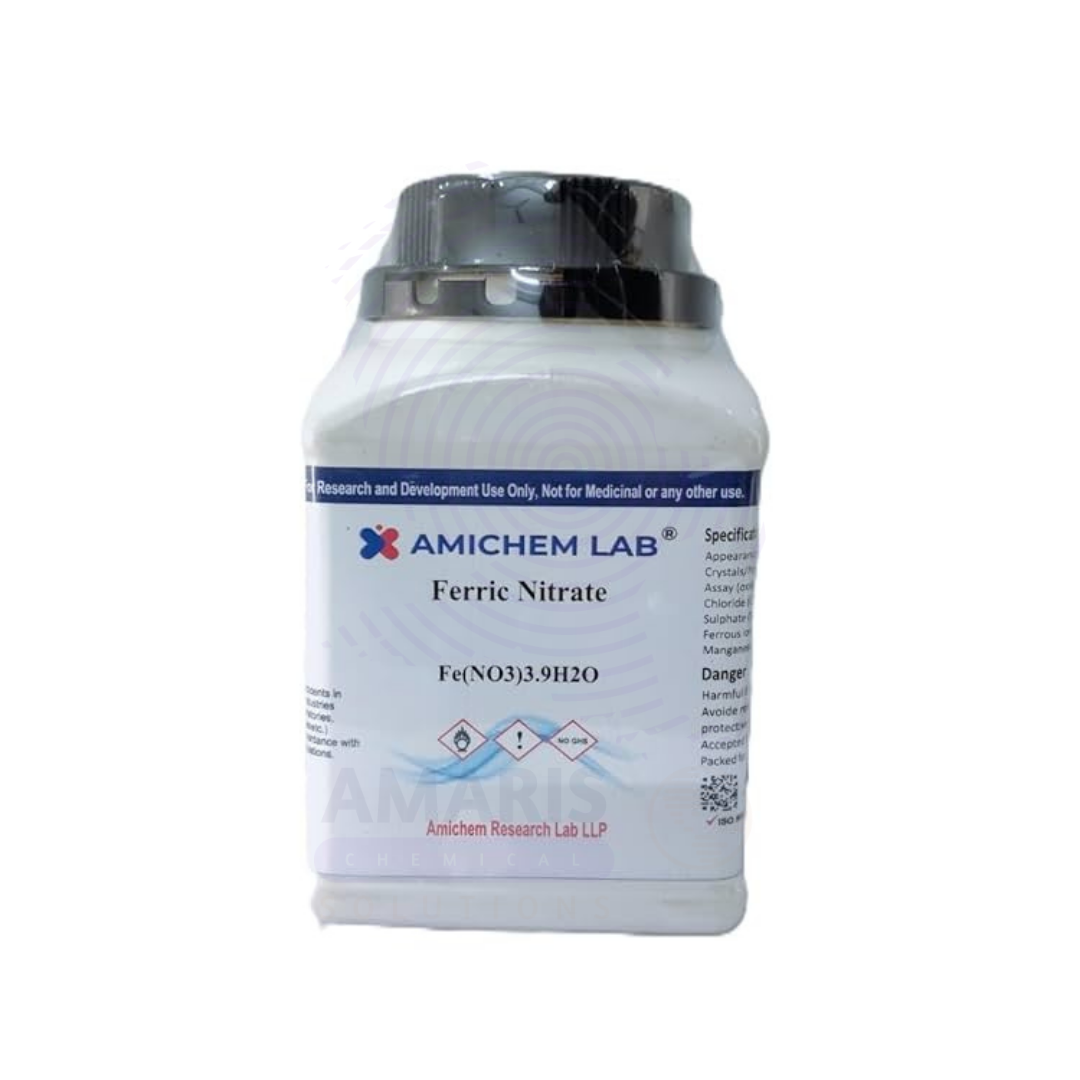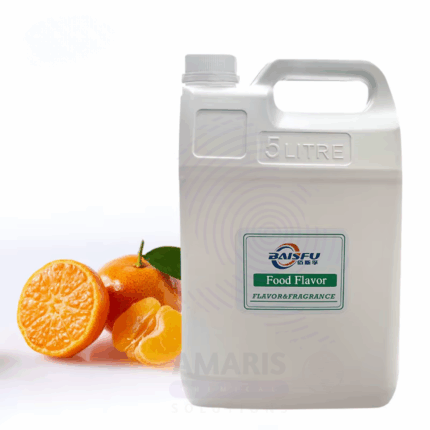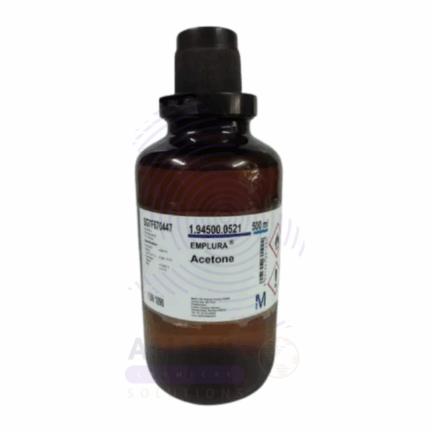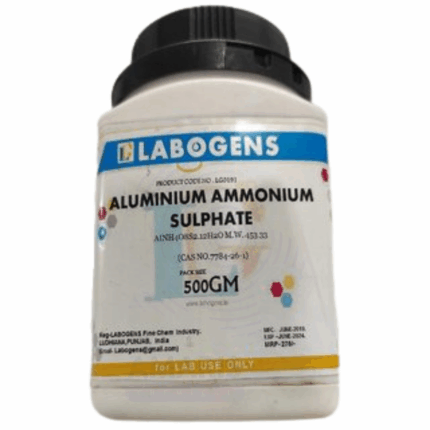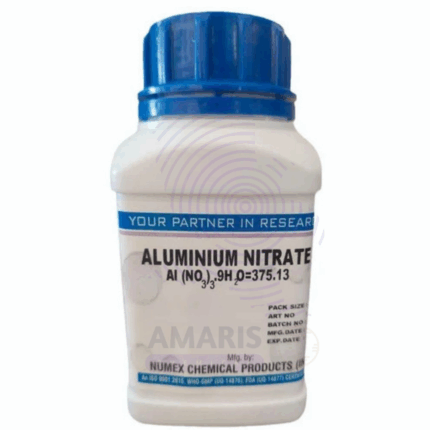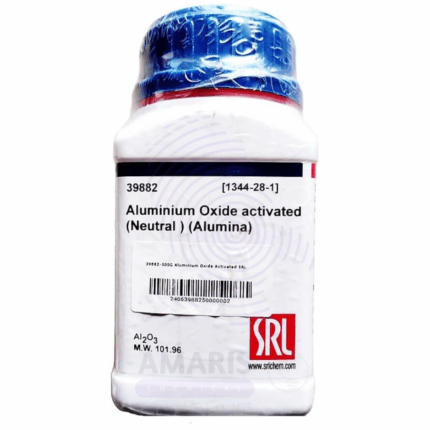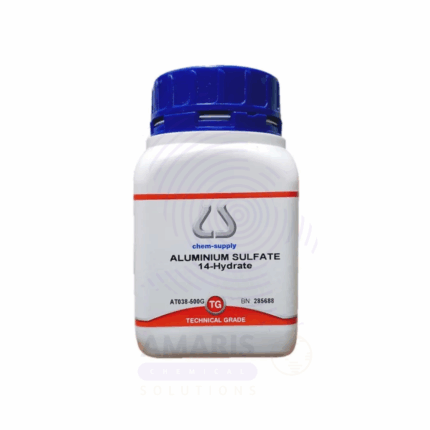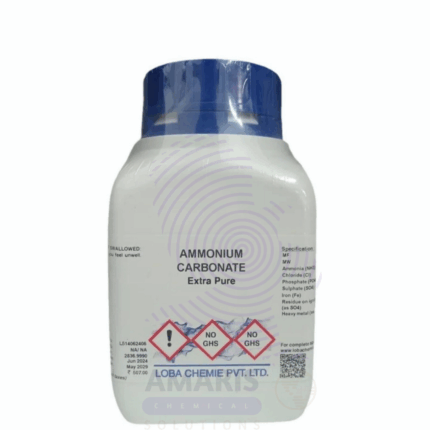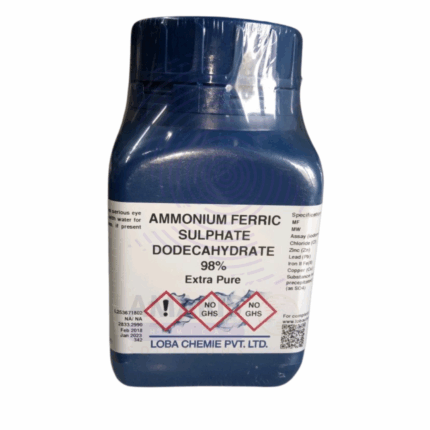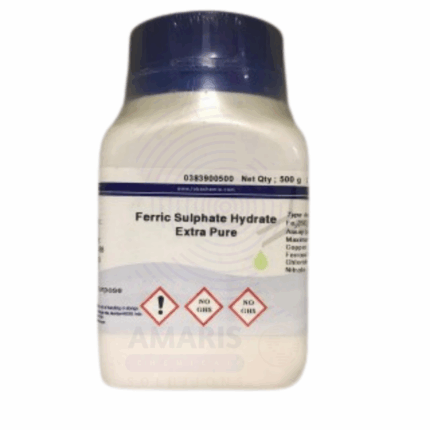
Ferric Nitrate Extra Pure
$ 20.10 Original price was: $ 20.10.$ 19.98Current price is: $ 19.98.
Ferric Nitrate Extra Pure is a high-purity iron(III) salt (Fe(NO₃)₃) commonly used in analytical chemistry, inorganic synthesis, and qualitative analysis. In the lab, it serves as an oxidizing agent and a source of ferric ions in solution. It’s also employed in the preparation of coordination compounds, as a catalyst, and in various colorimetric tests. Its extra pure grade ensures low levels of contaminants, making it suitable for precision laboratory applications.
Ferric Nitrate Extra Pure
Primary Uses
- Oxidizing agent in chemical reactions:
Acts as a strong oxidizer in various redox reactions and organic transformations. - Source of iron(III) ions in solution:
Commonly used to provide Fe³⁺ ions in analytical chemistry, coordination complex studies, and titrations. - Preparation of iron coordination compounds:
Used in synthesizing iron-containing complexes for research and teaching in inorganic chemistry. - Precipitation reactions and qualitative analysis:
Reacts with suitable anions (e.g., thiocyanate, phosphate) for identification or demonstration purposes.
Secondary Uses
- Catalyst in organic synthesis:
Functions as a Lewis acid in some catalytic processes. - Demonstrating corrosion and rust chemistry:
Useful in simulating oxidation processes involving iron. - Nutrient solution additive in plant biology studies:
Occasionally used in hydroponic experiments for iron supplementation in trace amounts. - Coloration studies in ceramic and glass experiments:
Can be used as a colorant to introduce iron-based hues during high-temperature testing.
| PACK SIZE |
500 grams Plastic Tin |
|---|
1. Basic Identification Attributes
- Chemical Name: Ferric Nitrate
- Synonyms: Iron(III) nitrate nonahydrate, Iron nitrate
- Chemical Formula: Fe(NO₃)₃·9H₂O
- Molecular Weight: 404.00 g/mol
- Grade: Extra Pure (Laboratory Reagent Grade)
- Appearance: Violet to reddish-brown crystalline solid
- Odor: Odorless
2. Physical & Chemical Properties
- Melting Point: ~47 °C (decomposes above 125 °C)
- Solubility: Highly soluble in water and alcohol
- pH (1% soln): Acidic
- Hygroscopic: Yes
- Decomposition: Produces nitrogen oxides and iron oxides
3. Safety & Hazard Attributes
- GHS Classification:
- Oxidizing solid (Category 3)
- Acute toxicity (Oral, Category 4)
- Eye irritation (Category 2A)
- Hazard Statements:
- H272: May intensify fire; oxidizer
- H302: Harmful if swallowed
- H319: Causes serious eye irritation
- PPE Requirements:
- Gloves (nitrile or neoprene)
- Safety goggles
- Lab coat
- Use in ventilated space or fume hood
- First Aid Measures:
- Inhalation: Move to fresh air; seek medical attention
- Skin Contact: Wash with soap and water
- Eye Contact: Rinse with plenty of water for 15+ minutes
- Ingestion: Rinse mouth; do not induce vomiting; seek medical help
4. Storage & Handling Attributes
- Storage Conditions:
- Store in tightly sealed container
- Keep away from heat, moisture, and combustible materials
- Store in a cool, dry, well-ventilated area
- Handling Notes:
- Avoid contact with skin and eyes
- Avoid inhaling dust or vapors
- Keep away from reducing agents
5. Regulatory & Compliance Attributes
- CAS Number: 7782-61-8
- EC Number: 233-899-5
- UN Number: UN 1466
- Hazard Class: 5.1 (Oxidizer)
- Packaging Group: III
6. Laboratory Applications
- Primary Uses:
- Oxidizing agent in organic and inorganic syntheses
- Reagent for detection of thiocyanates and phenols
- Catalyst in nitration reactions
- Preparation of other ferric salts
- Secondary Uses:
- Etching agent for metals
- Laboratory demonstration of oxidation-reduction reactions
- Colorimetric analysis in analytical chemistry
SAFETY PRECAUTIONS
- Oxidizing and corrosive – can intensify fire
- Can cause serious eye damage and skin irritation
- Handle with gloves, goggles, and protective clothing
- Use in well-ventilated areas or fume hoods
Storage:
- Store in a cool, dry, and well-ventilated area
- Keep away from heat, organic substances, and reducing agents
- Use non-metal containers if possible
FIRST AID MEASURES
- Inhalation: Move to fresh air and seek medical attention if symptoms persist
- Skin Contact: Rinse thoroughly with water, remove contaminated clothing
- Eye Contact: Flush eyes for 15+ minutes and seek immediate medical help
- Ingestion: Do not induce vomiting; rinse mouth and seek medical attention immediately
Related products
Acetone Extra Pure
Aluminium Ammonium Sulphate Extra Pure
Aluminium Nitrate Extra Pure
Aluminium Oxide Active Neutral Extra Pure
Aluminium Sulphate Hydrous Extra Pure
Ammonium Carbonate Extra Pure
Ammonium Carbonate Extra Pure is a high-quality, white crystalline solid widely used across various scientific, industrial, and food-related applications. Manufactured to stringent purity standards, this compound is ideal for laboratories and processes that demand high-grade reagents. With its characteristic ammonia-like odor and ability to decompose upon heating, ammonium carbonate plays a versatile role in both chemical reactions and physical processes.
In aqueous solution, ammonium carbonate breaks down into ammonium bicarbonate and ammonium carbamate, further releasing ammonia (NH₃) and carbon dioxide (CO₂) upon heating. This property makes it especially useful in applications that require controlled gas release or temporary pH modification.


 Preservatives(food)
Preservatives(food) Flavor Enhancers
Flavor Enhancers Acidulants
Acidulants Sweeteners
Sweeteners Antioxidants
Antioxidants Colorants(food)
Colorants(food) Nutraceutical Ingredients (food)
Nutraceutical Ingredients (food) Nutrient Supplements
Nutrient Supplements Emulsifiers
Emulsifiers
 Collectors
Collectors Dust Suppressants
Dust Suppressants Explosives and Blasting Agents
Explosives and Blasting Agents Flocculants and Coagulants
Flocculants and Coagulants Frothers
Frothers Leaching Agents
Leaching Agents pH Modifiers
pH Modifiers Precious Metal Extraction Agents
Precious Metal Extraction Agents
 Antioxidants(plastic)
Antioxidants(plastic) Colorants (Pigments, Dyes)
Colorants (Pigments, Dyes) Fillers and Reinforcements
Fillers and Reinforcements Flame Retardants
Flame Retardants Monomers
Monomers Plasticizers
Plasticizers Polymerization Initiators
Polymerization Initiators Stabilizers (UV, Heat)
Stabilizers (UV, Heat)
 Antifoaming Agents
Antifoaming Agents Chelating Agents
Chelating Agents Coagulants and Flocculants
Coagulants and Flocculants Corrosion Inhibitors
Corrosion Inhibitors Disinfectants and Biocides
Disinfectants and Biocides Oxidizing Agents
Oxidizing Agents pH Adjusters
pH Adjusters Scale Inhibitors( water)
Scale Inhibitors( water)
 Antioxidants(cosmetic)
Antioxidants(cosmetic) Emollients
Emollients Fragrances and Essential Oils
Fragrances and Essential Oils Humectants
Humectants Preservatives
Preservatives Surfactants(cosmetic)
Surfactants(cosmetic) Thickeners
Thickeners UV Filters
UV Filters
 Fertilizers
Fertilizers Soil Conditioners
Soil Conditioners Plant Growth Regulators
Plant Growth Regulators Animal Feed Additives
Animal Feed Additives Biostimulants
Biostimulants Pesticides (Herbicides, Insecticides, Fungicides)
Pesticides (Herbicides, Insecticides, Fungicides)
 Active Pharmaceutical Ingredients (APIs)
Active Pharmaceutical Ingredients (APIs) Excipients
Excipients Solvents(pharmaceutical)
Solvents(pharmaceutical) Antibiotics
Antibiotics Antiseptics and Disinfectants
Antiseptics and Disinfectants Vaccine Adjuvants
Vaccine Adjuvants Nutraceutical Ingredients (pharmaceutical)
Nutraceutical Ingredients (pharmaceutical) Analgesics & Antipyretics
Analgesics & Antipyretics
 Analytical Reagents
Analytical Reagents Solvents(lab)
Solvents(lab) Chromatography Chemicals
Chromatography Chemicals Spectroscopy Reagents
Spectroscopy Reagents microbiology-and-cell-culture-reagents
microbiology-and-cell-culture-reagents Molecular Biology Reagents
Molecular Biology Reagents Biochemical Reagents
Biochemical Reagents Inorganic and Organic Standards
Inorganic and Organic Standards Laboratory Safety Chemicals
Laboratory Safety Chemicals Specialty Laboratory Chemicals(Special Laboratory Equipment)
Specialty Laboratory Chemicals(Special Laboratory Equipment)
 Demulsifiers
Demulsifiers Hydraulic Fracturing Fluids
Hydraulic Fracturing Fluids Scale Inhibitors(oil)
Scale Inhibitors(oil) Surfactants(oil)
Surfactants(oil) Drilling Fluids
Drilling Fluids
 Dyes and Pigments
Dyes and Pigments Bleaching Agents
Bleaching Agents Softening Agents
Softening Agents Finishing Agents
Finishing Agents Antistatic Agents
Antistatic Agents
 Admixtures
Admixtures Waterproofing Agents
Waterproofing Agents Sealants and Adhesives
Sealants and Adhesives Curing Compounds
Curing Compounds Concrete Repair Chemicals
Concrete Repair Chemicals Anti-Corrosion Coatings
Anti-Corrosion Coatings
 Surfactants(cleaning)
Surfactants(cleaning) Builders
Builders Enzymes
Enzymes Solvents (Cleaning)
Solvents (Cleaning) Fragrances
Fragrances
 Electronic Chemicals
Electronic Chemicals Catalysts
Catalysts Lubricants
Lubricants Photographic Chemicals
Photographic Chemicals Refrigerants
Refrigerants Automotive chemicals
Automotive chemicals Pyrotechnic Chemicals
Pyrotechnic Chemicals
 Biodegradable Surfactants
Biodegradable Surfactants Bio-based Solvents
Bio-based Solvents Renewable Polymers
Renewable Polymers Carbon Capture Chemicals
Carbon Capture Chemicals Wastewater Treatment Chemicals
Wastewater Treatment Chemicals
 Pigments
Pigments Solvents(paint)
Solvents(paint) Specialty Coatings
Specialty Coatings Binders/Resins
Binders/Resins Additives
Additives Driers
Driers Anti-Corrosion Agents
Anti-Corrosion Agents Functional Coatings
Functional Coatings Application-Specific Coatings
Application-Specific Coatings
 Fresh Herbs
Fresh Herbs Ground Spices
Ground Spices Whole Spices
Whole Spices Spice Blends
Spice Blends Dried Herbs
Dried Herbs
 Leavening Agents
Leavening Agents Dough Conditioners
Dough Conditioners Flour Treatments
Flour Treatments Fat Replacers
Fat Replacers Decoratives
Decoratives Preservatives(baking)
Preservatives(baking)
 Plasticizers & Softeners
Plasticizers & Softeners Reinforcing Agents
Reinforcing Agents Adhesion Promoters
Adhesion Promoters Vulcanizing Agents
Vulcanizing Agents Antidegradants
Antidegradants Blowing Agents
Blowing Agents Fillers & Extenders
Fillers & Extenders Accelerators & Retarders
Accelerators & Retarders